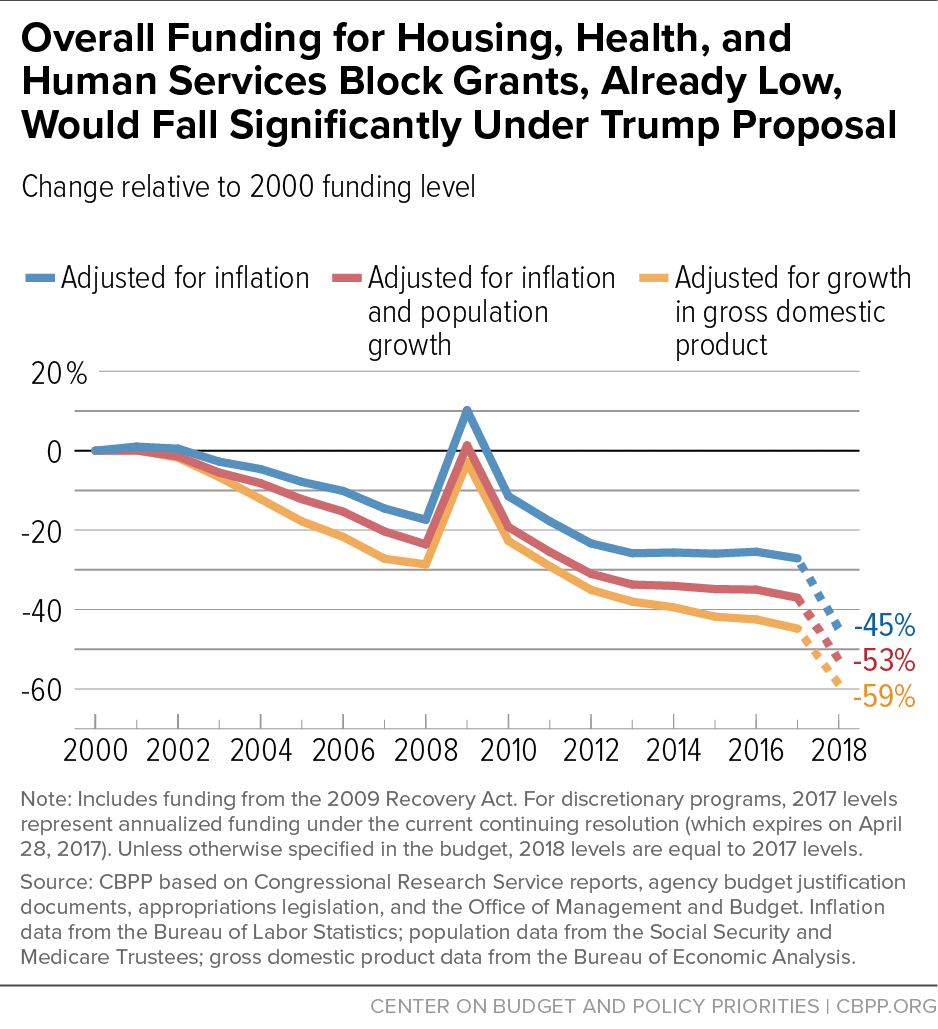- Home
- Federal Budget
- Trump Budget Would Cut Block Grants Dram...
Trump Budget Would Cut Block Grants Dramatically, Underscoring Danger of Block-Granting Social Programs
President Trump’s “skinny” budget would eliminate four discretionary block grants that mainly serve low-income people, and set the stage for substantial cuts to others. As a result, it would reduce overall funding for block grants for low- and moderate-income people that are “discretionary” (or annually appropriated) programs by half or more just between 2017 and 2018.
These cuts would come on top of years of deteriorating funding for block grants. Since 2000, overall funding for block grants targeted on low- and moderate-income people — including both discretionary and mandatory programs — has shrunk by 27 percent in inflation-adjusted terms and 37 percent after accounting for inflation and population growth. The Trump cuts would sharply exacerbate those declines.
The proposals point to a longstanding inconsistency by some conservative policymakers. The proposals point to a longstanding inconsistency by some conservative policymakers. They often argue for creating new block grants to give states needed flexibility to operate programs to best address their needs. Yet conservatives also often support sharply cutting or eliminating various existing block grants, commonly arguing that the block grants don’t generate evidence of effectiveness. Such claims are frequently overblown or inaccurate. At the same time, the very structure of a block grant can make it hard to measure and show effectiveness on a national scale — especially when, as repeatedly occurs, the President and Congress designed the block grant to provide sweeping state or local flexibility to use federal funds and reduce federal accountability over them.
In other words, policymakers sometimes cite the effects of the structural change that they typically advocate when they propose block grants as their reason, in later years, to sharply cut or eliminate those block grants.
The Proposed Cuts
From a list of federal block grants compiled by the Congressional Research Service, we conducted a comprehensive review of funding trends for all federal housing, health, and social services block grants.[1] Ten of these block grants are funded as discretionary programs, one includes both discretionary and mandatory funds, and two are fully funded as mandatory programs. (Taken together, a bit more than half of all funding for block grants for low-income people is for mandatory programs.)
President Trump’s budget would eliminate four of the discretionary block-grant programs:
- the Low Income Home Energy Assistance Program (LIHEAP), which helps low-income households — including many poor seniors — pay heating bills (with current funding at $3.4 billion);
- the Community Development Block Grant (CDBG), which supports housing, community facilities, economic development, and social service projects, mainly for low- and moderate-income residents ($3 billion);
- the HOME program, which helps develop and preserve affordable rental housing and repair homes of low-income homeowners ($948 million); and
- the Community Services Block Grant (CSBG), which provides anti-poverty services through local non-profit and public agencies ($714 million).
Eliminating these four block grants would cut overall funding for discretionary block grants by $8.0 billion — or 47 percent — from its $17.2 billion level in 2017. That 47 percent doesn’t account for inflation or any cuts, rather than outright eliminations, to block-grant programs that may flow from the austere discretionary funding targets that the President has set for most federal departments and agencies. The Administration won’t release information on most of the President’s cuts to individual programs until it releases his full budget later this spring.
But the “skinny” budget does contain hints of such cuts. In particular, it calls for a cut in the federal government’s principal job training program, stating that the President’s budget “Decreases Federal support for job training and employment service formula grants”[2] — which make up the job training block grant. Assuming that this program shrinks by 21 percent, which is the average cut to the Labor Department’s discretionary programs under the “skinny” budget, that raises the President’s overall funding cut to discretionary block-grant programs from $8.0 billion to $8.6 billion, or from 47 percent to 50 percent (see Table 1).
Lacking more information on the President’s specific program cuts, we haven’t calculated cuts for any other discretionary block grants. If those block grants are cut at all, the overall cuts in discretionary block grants will climb to more than 50 percent from 2017 to 2018.
| TABLE 1 | ||
|---|---|---|
| Trump Proposal Would Cut Discretionary Block Grants in Half or More | ||
| Program | Funding in 2017 (in millions of dollars) | Funding in 2018, under Trump proposal |
| Temporary Assistance for Needy Families (TANF) block grant | $16,574 | |
| Child Care and Development Fund | 5,673 | |
| Child Care Entitlements to States | 2,917 | |
| Child Care and Development Block Grant | 2,756 | ? |
| Low Income Home Energy Assistance Program | 3,384 | 0 |
| Community Development Block Grant | 2,994 | 0 |
| Job Training Formula Grants to States (Youth, Adult, and Dislocated Workers) | 2,705 | 2,129* |
| Substance Abuse Prevention and Treatment Block Grant | 1,855 | ? |
| Social Services Block Grant | 1,583 | |
| HOME Investment Partnerships Program | 948 | 0 |
| Community Services Block Grant | 714 | 0 |
| Native American Housing Block Grant | 647 | ? |
| Maternal and Child Health Block Grant | 550 | ? |
| Community Mental Health Services Block Grant | 532 | ? |
| Preventive Health and Health Services Block Grant | 160 | ? |
| Total | $38,317 | |
| Discretionary programs only | $17,245 | Known cut: -$8,616 |
* Assumes a 21% cut -- the overall percentage cut to discretionary programs under the Labor Department’s jurisdiction.
Note: For discretionary programs, 2017 levels represent annualized funding under the current continuing resolution. 2018 funding levels for mandatory programs – TANF, child care entitlements for states, and the Social Services Block Grant -- are left blank.
Source: CBPP calculations based on data from the Office of Management and Budget and appropriations legislation.
Block grants have already faced substantial cuts in recent years. Since 2000, overall funding for the 13 major block grants that help low-income people has shrunk by 27 percent after adjusting for inflation (and 37 percent after adjusting for inflation and population growth).[3] Funding for all but one of these 13 major block grants has fallen, in most cases sharply.
In Figure 1 below, the dotted line shows how the Trump proposal would generate a sharp drop-off, on top of years of funding declines. The drop-off is severe, even though we consider only the explicit cuts to discretionary block grants under the Trump budget, and not the implicit cuts to discretionary block grants or any cuts to block grants funded as mandatory programs. As noted, most block-grant funding is on the mandatory side, and we won’t know whether the President is seeking cuts in those programs until he releases his full budget in May. Still, even under the scenario reflected in the graph, overall funding for block-grant programs would be 45 percent lower in 2018 than in 2000 in inflation-adjusted terms, and 53 percent lower after accounting for inflation and population growth.
The Longstanding Contradictory Pattern
The Trump proposal reflects a longstanding pattern of inconsistency by some conservative policymakers when it comes to block grants. They often argue to convert existing programs into block grants largely to give states the necessary flexibility to make the programs work better. Then, some years later, they or their counterparts argue to cut or eliminate such block grants.
Frequently, policymakers cite the very flexibility that block grants provide to state and local governments as their reason to cut or end them. The increased flexibility and diminished accountability over using federal funds that are built into the basic structure of many block grants mean that states can use the funds in highly diffuse ways, making a block grant’s impact much harder to assess. That, in turn, can eventually prompt federal policymakers who are seeking budget cuts to target block grants and argue that block-grant programs lack sufficient evidence of effectiveness. In arguing to end funding for such block grants as LIHEAP, CSBG, and CDBG, the Trump budget adopts this line, asserting that their impact is wanting (and ignoring evidence that points in the other direction).
Ironically, while proposing to eliminate these four block grants, the President also proposes to create a new one: a $500 million block grant at the Centers for Disease Control and Prevention that would apparently come from consolidating — and presumably cutting — various categorical grants. His budget says that would “increase State flexibility and focus on the leading public health challenges specific to each State.”[4] In addition, the health care legislation that had been advanced by House Republican leaders, with President Trump’s support, included a provision to turn Medicaid into a per capita cap (a structural cousin to a block grant)[5] or, at state option, a block grant for children and some adults. (This legislation was pulled from consideration on March 24 as it lacked the necessary votes for passage.)
Decades of block-grant funding trends, along with the new Trump proposals to slice discretionary block grants deeply, suggest the likely effect of such changes would be significant funding cuts over time.
Block-Granting Low-Income Programs Leads to Large Funding Declines Over Time, History Shows
End Notes
[1] David Reich, Isaac Shapiro, Chloe Cho, and Richard Kogan, “Block-Granting Low-Income Programs Leads to Large Funding Declines Over Time, History Shows,” CBPP, February 22, 2017, https://www.cbpp.org/research/federal-budget/block-granting-low-income-programs-leads-to-large-funding-declines-over-time.
[2] Office of Management and Budget, America First: A Budget Blueprint to Make America Great Again, March 16, 2017, p. 31.
[3] Block grants on both the discretionary and mandatory sides of the budget fell substantially over this period, with the overall funding of discretionary block grants declining by 35 percent after accounting for inflation and population growth, and the overall funding of block grants on the mandatory side declining by 39 percent using this metric.
[4] The Trump Administration’s “skinny” budget does not indicate which existing grants or programs the block grant would replace.
[5] Edwin Park, “Medicaid Per Capita Cap Would Shift Costs and Risks to States and Harm Millions of Beneficiaries,” CBPP, revised February 27, 2017. https://www.cbpp.org/research/health/medicaid-per-capita-cap-would-shift-costs-and-risks-to-states-and-harm-millions-of.
More from the Authors

Recent Work:



